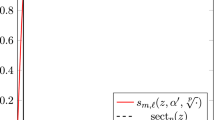Abstract
The problem of computing the roots of a particular sequence of sparse polynomials pn(t) is considered. Each instance pn(t) incorporates only the n + 1 monomial terms \(t,t^{2},t^{4},\ldots ,t^{2^{n}}\) associated with the binomial coefficients of order n and alternating signs. It is shown that pn(t) has (in addition to the obvious roots t = 0 and 1) precisely n − 1 simple roots on the interval (0,1) with no roots greater than 1, and a recursion relating pn(t) and pn+ 1(t) is used to show that they possess interlaced roots. Closed–form expressions for the Bernstein coefficients of pn(t) on [0,1] are derived and employed to compute the roots in double–precision arithmetic. Despite the severe variation of the graph of pn(t), and tight clustering of roots near t = 1, it is shown that for n ≤ 10, the roots on (0,1) are remarkably well–conditioned and can be computed to high accuracy using both the power and Bernstein forms.








Similar content being viewed by others
Notes
It is understood here that these sub–intervals are both mapped to [0, 1] through the transformations t → t/τ and t → (t − τ)/(1 − τ), respectively.
The authoritative compilation of summation formulas [10] contains no examples that include the summation index as an exponent within the binomial coefficients.
Note, however, that not all of these coefficients admit a finite binary representation, and small errors may be incurred in converting them to floating–point numbers.
References
Erdös, P., Rényi, A.: On random graphs. I. Publ. Math. Debrecen 6, 290–297 (1959)
Farin, G.E.: Curves and Surfaces for Computer–Aided Geometric Design: a Practical Guide, 3rd edn. Academic Press, Boston (1993)
Farouki, R.T.: The Bernstein polynomial basis: a centennial retrospective. Comput. Aided Geom. Des. 29, 379–419 (2012)
Farouki, R.T., Goodman, T.N.T.: On the optimal stability of the Bernstein basis. Math. Comput. 65, 1553–1566 (1996)
Farouki, R.T., Rajan, V.T.: On the numerical condition of polynomials in Bernstein form. Comput. Aided Geom. Des. 4, 191–216 (1987)
Gautschi, W.: On the condition of algebraic equations. Numer. Math. 21, 405–424 (1973)
Gautschi, W.: Questions of Numerical Condition Related to Polynomials, Studies in Numerical Analysis. In: Golub, G.H. (ed.) , vol. 24, pp 140–177. MAA Studies in Mathematics (1984)
Goetgheluck, P.: Computing binomial coefficients. Am. Math. Month. 94, 360–365 (1987)
Goetgheluck, P.: On prime divisors of binomial coefficients. Math. Comput. 51, 325–329 (1988)
Gould, H.W.: Combinatorial Identities: a Standardized Set of Tables Listing 500 Binomial Coefficient Summations. Gould Publications, Morgantown (1972)
Henrici, P.: Elements of Numerical Analysis. Wiley, New York (1964)
Uspensky, J.V.: Theory of Equations. McGraw–Hill, New York (1948)
Wilkinson, J.H.: The evaluation of the zeros of ill–conditioned polynomials, parts I & II. Numer. Math. 1, 150–166 & 167–180 (1959)
Wilkinson, J.H.: Rounding Errors in Algebraic Processes. Prentice–Hall, Englewood Cliffs (1963)
Wilkinson, J.H.: The Perfidious Polynomial, Studies in Numerical Analysis. In: Golub, G.H. (ed.) , vol. 24, pp 1–28. MAA Studies in Mathematics (1984)
Wilkinson, J.H.: The Algebraic Eigenvalue Problem. Clarendon Press, Oxford (1988)
Author information
Authors and Affiliations
Corresponding author
Additional information
Publisher’s note
Springer Nature remains neutral with regard to jurisdictional claims in published maps and institutional affiliations.
Rights and permissions
About this article
Cite this article
Farouki, R.T., Strom, J.A. Computing the roots of sparse high–degree polynomials that arise from the study of random simplicial complexes. Numer Algor 83, 1653–1670 (2020). https://doi.org/10.1007/s11075-019-00745-3
Received:
Accepted:
Published:
Issue Date:
DOI: https://doi.org/10.1007/s11075-019-00745-3




